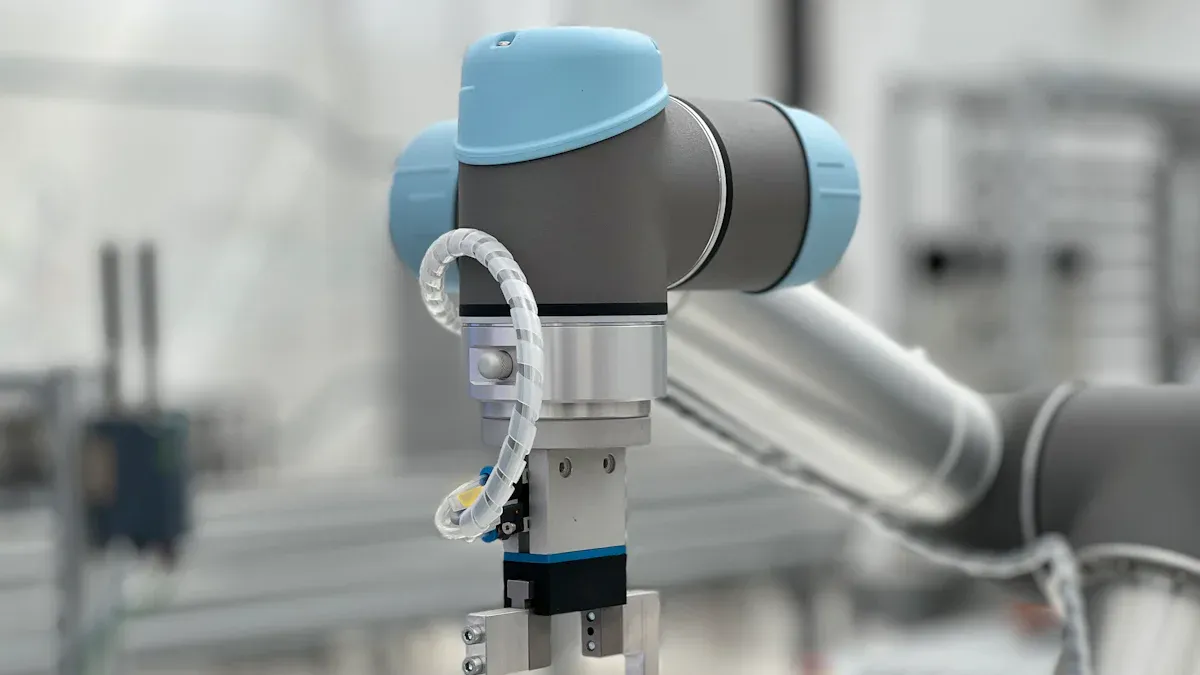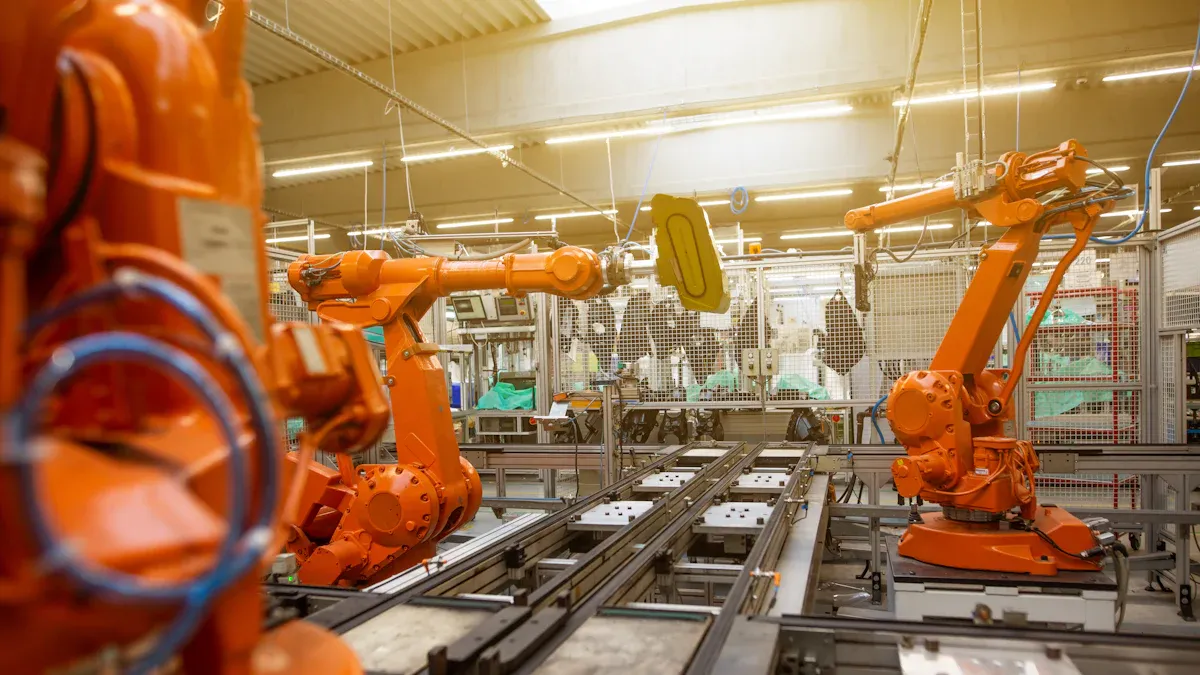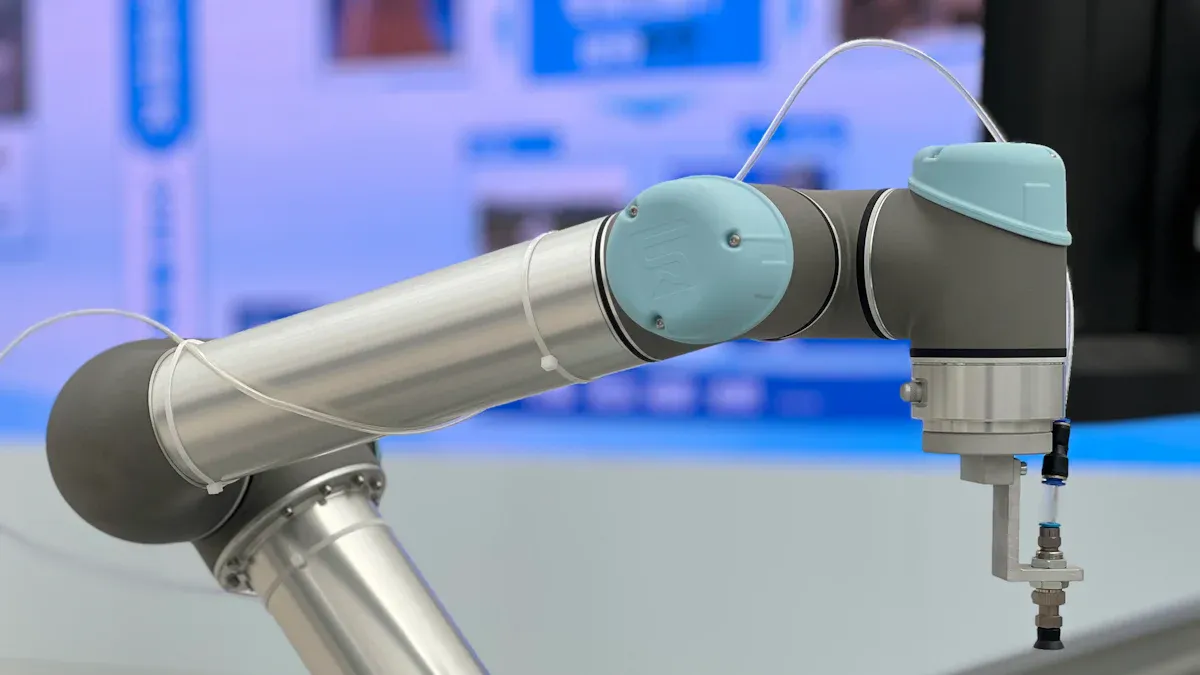Why do automated retail stores source merchandise using robotics

Automated retail stores use robotics to help you get products faster, keep shelves stocked, and make shopping smoother. When robots manage tasks like shelf stocking or inventory checks, you see fewer empty shelves and faster service. Over 70% of warehouses with robots report big gains in speed and productivity. Stores like Walmart use hundreds of robots to track inventory, answer questions, and improve your experience every day.
Key Takeaways
Robots improve shopping speed by handling tasks like inventory checks and shelf stocking, leading to fewer empty shelves.
Automated systems work 24/7, ensuring constant inventory monitoring and faster service for customers.
Robots enhance stock accuracy by frequently scanning shelves, which helps stores restock quickly and reduce mistakes.
Using robotics lowers operational costs, allowing stores to offer better prices and improve customer service.
Robots assist in customer interactions by providing product information and guiding shoppers, making the shopping experience smoother.
Efficiency in Automated Retail Stores

Faster Operations
You see faster service in automated retail stores because robots handle many tasks at once. Robots scan shelves to check prices and spot missing products. They compare shelf prices with the store’s database and flag mistakes for quick fixes. Robots also look at shelf layouts and help keep products in the right place.
Shelf-scanning robots automate price checks and keep merchandising standards high.
Robots compare shelf prices with central databases and catch errors.
Robots check shelf layouts and help with product placement.
Stores using inventory robots report up to 90% fewer pricing mistakes and promotion errors. You notice fewer empty shelves because robots detect out-of-stock items quickly. Some stores see a 60% drop in out-of-stock products, which means you find what you need more often.
Simbe’s Tally robot scans shelves on its own and finds missing items or wrong price tags. Leading retailers use this technology to make fewer mistakes and run stores more smoothly.
Robots work with retail management software to track products and restock shelves. Portable robots collect store data quickly and accurately. They scan shelves, track where products are, and measure how much space each item uses. This helps stores keep products available for you.
24/7 Availability
Robots in automated retail stores work day and night. You benefit from stores that never stop checking inventory or fixing problems. Robots do not need breaks, so they keep shelves stocked and prices correct all the time.
Robots work around the clock, reducing downtime and speeding up operations.
Sensors on robots monitor equipment health and help with maintenance before problems happen.
Stores see big improvements in speed when robots work nonstop. For example, average turnover time drops from 99.2 minutes to 53.2 minutes after robots start working. Room ready time goes down from 42.2 minutes to 27.2 minutes. These changes mean you spend less time waiting for products to be restocked or for prices to be updated.
Robots help stores measure how well they work. Stores use key performance indicators like Overall Equipment Effectiveness (OEE), Mean Time Between Failures (MTBF), and Mean Time to Repair (MTTR) to track robot performance. Stores also check customer satisfaction with Net Promoter Score (NPS). When robots work well, you get better service and find products faster.
Inventory Management

Accurate Stock Tracking
You benefit from accurate stock tracking when automated retail stores use robotics. Robots scan shelves and count products many times each day. This frequent checking helps stores keep track of every item and reduces mistakes. Robots use cameras and sensors to spot misplaced products and out-of-stock situations. You see fewer empty shelves because robots send real-time data to store managers, who can restock quickly.
Here is how robotics improves stock tracking:
Benefit | Description |
|---|---|
Boost accuracy & frequency | |
Increase labor efficiency | Staff spend less time on manual checks and more time helping you. |
Improve in-store order fulfillment | Stores know exactly what is in stock, so your online orders get filled correctly. |
Understand and reduce shrink | Robots track every item, helping stores control losses. |
Continuous shelf monitoring | Stores get up-to-date digital records of inventory. |
Fast and easy AI-powered analytics | Stores use data to predict what you want and keep products in the right place. |
Seamless integration | Robots work with store systems for smooth inventory management. |
Robots like Dexory scan thousands of pallet locations every hour. You get better service because stores know what is available and can fill orders faster. Robots also help stores avoid mistakes during busy times by giving instant feedback and alerts.
Streamlined Replenishment
You see full shelves more often because robots help stores restock quickly. Robots track inventory levels and send alerts when products run low. This proactive approach means you rarely find empty shelves. Stores use AI to predict which items need restocking, so you get what you want without waiting.
Here are some benefits of streamlined replenishment:
AI reduces inventory costs by up to 20% and cuts stockouts by 50%.
Stores forecast inventory needs more accurately, so you miss fewer sales.
Smarter replenishment keeps shelves full and prevents markdowns.
Robots also work in warehouses and distribution centers. They pick and pack products with high accuracy, especially during busy times like holidays. Automated systems reduce errors and make order fulfillment faster. You get your products sooner and with fewer mistakes.
Benefit | Description |
|---|---|
Improved Efficiency | Robots speed up picking and packing, especially during peak periods. |
Fewer Errors | Automated systems lower mistakes in packing and data entry. |
Optimized Space Utilization | Stores use warehouse space better, saving money and keeping more products available. |
Better Customer Service | Faster and more accurate orders make you happier and more loyal. |
Cost-Effectiveness | Stores spend less on labor and operations, so you get better prices. |
Automated retail stores use robotics to keep shelves stocked and orders accurate. You enjoy a smoother shopping experience and find what you need more often.
Cost and Labor
Lower Expenses
You save money when automated retail stores use robotics for sourcing merchandise. Robots help stores cut costs in many ways. For example, Amazon reported a 25% reduction in costs after adding AI-based robots to their fulfillment centers. These robots pick, sort, and pack products faster than humans. Analysts predict that robotics for deliveries could save retailers over $7.1 billion each year by 2032.
Robots work without breaks, which means stores do not pay for overtime or extra shifts. You benefit from lower prices and better deals because stores spend less on labor and operations.
Here is a table showing how robotics helps reduce labor expenses:
Evidence Description | Key Points |
|---|---|
Labor cost reduction through robotics | Robots increase cleaning and inventory scanning frequency, lowering costs. |
Enhanced employee productivity | Stores reassign staff to customer-facing roles, improving service. |
Growth in robotics adoption | Robot installations surged by 31% (industrial) and 37% (service) in 2022. |
Retailers often see labor cost savings of 30-40% after using robots for inventory monitoring and product replenishment. The total cost of owning robots becomes much lower than hiring human workers within two to three years. You get faster service and more accurate orders because robots work all day and night.
Addressing Labor Shortages
You notice smoother store operations because robots help fill gaps when there are not enough workers. Automated retail stores use robotics systems like Autonomous Mobile Robots (AMRs) to handle tasks such as inventory management and floor cleaning. This lets human workers focus on helping you and solving problems.
Robots perform physical tasks, reducing the need for manual labor.
Stores use AI and automation to improve efficiency and rely less on manual workers.
Robots scan shelves and update stock levels, keeping products available for you.
The use of robotics also improves safety and sustainability in stores.
When stores face labor shortages, robots keep things running smoothly. You see clean floors, stocked shelves, and quick service even when there are fewer employees. Stores can redeploy workers to more valuable roles, such as customer service, which makes your shopping experience better.
Customer Experience
Product Information
You get better product information when you shop in automated retail stores. Robots help you find what you need by answering questions about products and stock levels. When you ask a robot about an item, it checks the latest data and gives you a quick answer. This makes your shopping trip easier and faster.
Almost two-thirds of shoppers say robots improve on-shelf accuracy. You see the right prices and find products where they belong.
Robots help you check if a product is in stock, so you do not waste time searching empty shelves.
You get help with promotions and discounts because robots keep price tags up to date.
Robots also help store staff focus on you. When robots handle routine questions, employees can spend more time helping you with special requests. Stores that use robots for customer service see higher satisfaction. For example, Liberty London saw a 9% increase in customer satisfaction after using AI to help with service tasks.
Tip: If you want to know if a product is available, ask a robot assistant. You will get a fast and accurate answer.
In-Store Guidance
Robots guide you through the store and help you find what you need. Some robots move around and show you where to go. Others answer your questions about store layout or product locations. This makes your visit smoother and more enjoyable.
How Robots Help Shoppers | |
|---|---|
Cleanliness | Robots clean floors, making the store look and feel welcoming. |
Inventory Management | Robots scan shelves and keep products available, so you find what you want. |
Customer Service | Robots handle simple tasks, so staff can focus on helping you directly. |
You also notice that robots make shopping more interactive. They talk with you, answer questions, and even remember your preferences. This creates a friendly and helpful atmosphere. Automation in retail stores improves your experience and helps you feel more satisfied with your visit.
Challenges and Considerations
Employment Impact
You may wonder how robotics in retail stores affects jobs. Robots can take over repetitive tasks, which helps reduce worker injuries and makes stores safer. The report "The new math: how AI robotics aligns safety and productivity in retail" shows that robots automate hazardous jobs, so you see fewer accidents. Some robots, like Café X, work alongside humans. They help with tasks such as order taking and troubleshooting, letting people focus on customer service. Other robots, like LoweBot, try to replace human roles. Sometimes, these robots struggle with complex requests, which can frustrate customers.
A study called "The Impact of Robotics on Employment and Motivation of Employees in the Service Sector" explains that robots bring both positive and negative changes. You see more efficiency and safety, but some workers may feel less motivated or worry about job security. Stores often start by using robots in non-customer-facing roles to avoid service problems. This helps balance the benefits of automation with the need for human interaction.
Tip: Robots can make stores safer and more efficient, but you still need people for tasks that require empathy and problem-solving.
Technical Issues
You might notice that robots in retail stores face many technical challenges. Retailers must make sure robots can adapt to seasonal changes and different product lines. The table below shows two common problems:
Challenge | Description |
|---|---|
Adaptability | Robots need to adjust to changing demands without expensive upgrades, especially in stores with many products. |
Scalability | Small retailers may struggle to afford robots, while large companies can test new technologies more easily. |
Robots can boost operational efficiency by up to 61%, but you see challenges like high upfront costs and the need for regular maintenance. Stores must deal with complex hardware and software integration. Many retailers find it hard to prepare data for AI models because information is scattered across different systems. Some stores lack experts who understand robotics and AI, which slows down adoption.
Lack of standardized solutions makes installation harder.
Integrating diverse electronics and mechanics creates extra work.
Many retailers do not have enough historical data to track inventory and delivery times.
You also see environmental concerns. Young shoppers want brands to be transparent and sustainable. Decathlon uses RFID technology to track products and reduce waste, which helps stores meet these demands.
Traceability builds trust and drives sustainability: RFID technology enables brands to track every step of a product’s journey—from sourcing to disposal—meeting customer demand for transparency and reducing waste in supply chains.
You see automated retail stores using robotics because they want to boost efficiency, keep shelves full, and give you better service. Robots help stores track products, lower costs, and make shopping easier. Many businesses plan to invest in robotics, and most shoppers feel comfortable with robot-run stores. In the future, you will notice more advanced robots using AI, working with people, and helping stores make smart decisions. These changes will shape how you shop and what you expect from stores.
Advanced technologies like AI and machine learning will play a bigger role.
Collaborative robots will work alongside staff.
Data-driven decisions will guide store operations.
Changes in rules and tariffs may affect how stores get products.
FAQ
How do robots know when to restock shelves?
Robots use cameras and sensors to scan shelves. They spot empty spots or low stock. The system sends alerts to staff or triggers automatic restocking. You see full shelves more often because of this smart technology.
Can robots help you find products in the store?
Yes! Many stores use robots that guide you to the right aisle or shelf. You can ask the robot for help, and it will show you where to go. This makes your shopping trip easier and faster.
Are robots safe to use around customers?
You stay safe around robots because they use sensors to avoid people and obstacles. Stores test robots to make sure they work safely. If a robot senses something in its path, it stops or changes direction.
Do robots replace all store workers?
No, robots do not replace all workers. Robots handle simple, repetitive tasks. You still see staff helping with questions, special requests, and customer service. Robots and people work together to improve your experience.
What happens if a robot breaks down?
If a robot stops working, the store gets an alert right away. Staff or technicians fix the problem quickly. Stores keep backup plans so you still get good service even if a robot has issues.
See Also
The Impact of AI Tools on E-Commerce Store Management
The Future of Retail Lies in AI-Powered Stores
Smart Technology in Vending Machines Is Changing Retail Forever
Fast Food Automation: The Role of Vending Machines Ahead
Essential Insights for Retailers on AI-Powered Corner Stores
